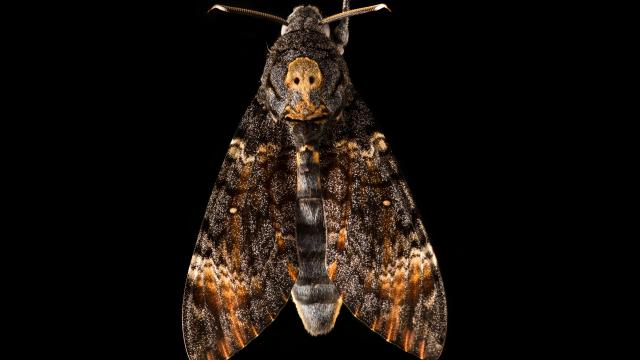It’s a bird, it’s a plane — no wait, it’s a migrating moth… being followed by a plane?
For the first time, scientists have continually tracked an insect over more than 80 km of a long-distance migration flight. The resulting observations and data reveal that at least one species of moth is capable of charting a surprisingly straight path. As small as these insects are, they seem to have a robust “internal compass” system that even allows them to navigate around tricky winds and geography, according to the new study published today in the journal Science.
Scientists have suspected that nocturnal, migratory insects way-find to optimise their flights, but until now researchers haven’t been able to demonstrate the mechanism in action, over a long and continuous distance.
What did they find?
In the new study, the researchers followed 14 death’s-head hawkmoths on a nighttime flight and were able to capture detailed tracks of half of the insects’ paths. They kept tabs on the moths for a mean distance of about 63 km and up to 89 km, and the moths reached a maximum groundspeed of more than 69 km per hour. The scientists also found that the insects’ flights were incredibly direct. The moths didn’t seem to be perturbed by wind or changes in the landscape. In fact, they seemed to compensate and account for those factors in their navigation.
“It was surprising that the moths flew on such straight tracks,” said lead study author, Myles Menz, an ecologist at James Cook University in Australia, in an email to Gizmodo. “It was also very interesting that the moths adjusted their strategy and could maintain such straight tracks even in unfavourable conditions such as head and crosswinds.”
All together, it indicates that the moths are relying on an “internal compass mechanism,” wrote the authors in the study. Menz added, “we hypothesise that they may use visual landmarks and perhaps the Earth’s magnetic field, to navigate.” Other animals, including birds, whales, and honeybees, are all believed to have similar navigation systems. But the exact mechanism for each remains something of a mystery.
Movie magic moths
Death’s-head hawkmoths breed in Europe’s Alps every spring and fly south to the Mediterranean and Africa in fall, migrating as far as 3,862 km. They notoriously reached silver screen fame as a recurring symbol in the 1991 movie The Silence of the Lambs. The insects are notable not just for their long migrations but also for the eerie markings on their thorax that sometimes resemble a human skull.
These extra-creepy crawlies might make migrating look easy, but capturing their movements was no simple feat. To do it, Menz and colleagues had to rear death’s-head caterpillars in the lab, fit each with a backpack-esque radio-transmitter once it metamorphosed into a moth, release those moths into the wild, and then follow them in a small aircraft for an entire night. Death’s-head hawkmoths are the largest species of moth or butterfly in Europe, which made them fit to manage the transmitters and ideal for tracking.
What couldn’t the researchers do?
Because following the moths was such a labour-intensive process, the researchers were only able to get detailed tracks of seven individuals, which is admittedly a small sample size. Yet the data they did find is compelling and convincing, said Colin Studds, an ecologist who studies animal migration at the University of Maryland and who wasn’t involved in the new research. “It is impressive to track such a small organism using a [radio] receiver in an aeroplane,” he wrote in an email to Gizmodo.
Yet Studds also pointed out another limitation of the study: 80 km is just a short segment of the moths’ total migratory journey. “It remains unknown if they can maintain their orientation as well for longer distances. It also raises the question if they can maintain course when they are running low on fuel stores,” he said.
Menz told Gizmodo that he would like to follow migrating moths over longer portions of their flights to shed light on the entire process, which remains enigmatic; even their exact overwintering destinations are unknown. “It would be great to track moths over their entire migration to determine where they are going,” he said.
For now, we know little about where the death’s-heads go every year, but at least we have a clearer sense of how efficiently they get there. These insects don’t need MapQuest (throwback Thursday); they have MothQuest.
